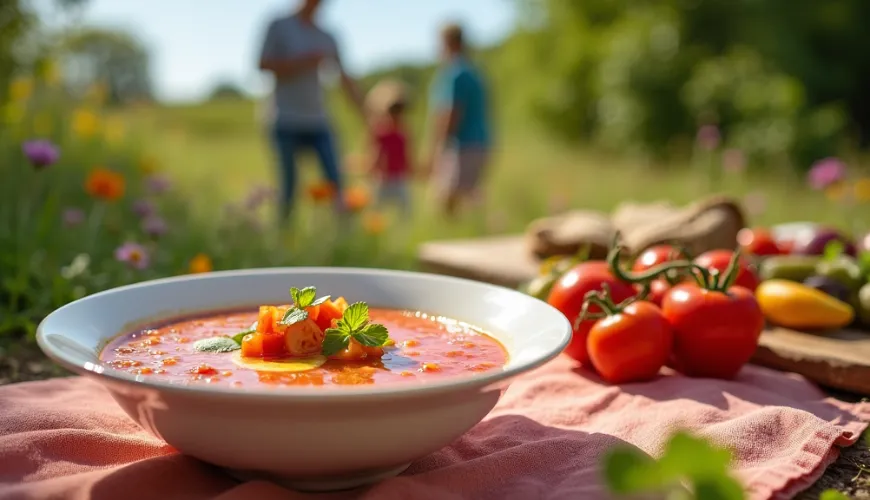
Gazpacho brings the taste of summer to your table with every bite

Refreshing Gazpacho - The Taste of Summer in a Cold Soup
When the sun is mercilessly blazing and temperatures are climbing to thirty degrees, few things delight more than something light, refreshing, and nutritious. That's when gazpacho comes into play – the traditional cold vegetable soup beloved by Mediterranean cuisine enthusiasts worldwide. If you haven't yet discovered this delicacy, it might be the right time to delve into its history, health benefits, and a simple homemade recipe.
A Tale from Hot Andalusia
Though we associate gazpacho primarily with Spanish cuisine today, its roots date back to the Moors and ancient Rome. The original version of this soup was very simple – water, olive oil, vinegar, garlic, and stale bread. It was only later, after the discovery of America, that tomatoes and peppers were added to the recipe, giving gazpacho its distinctive color and flavor.
Today, gazpacho is a symbol of summer in Spain, especially in Andalusia, where it is served as an appetizer, main course, or even a snack. And no wonder – in a region where summer temperatures often exceed 40°C, a cooling, light, and nutritious soup is literally a blessing.
Why You'll Love Gazpacho
At first glance, gazpacho might seem like an ordinary vegetable juice, but don't be fooled. This cold soup is not only rich in flavor but also in vitamins, minerals, and antioxidants. The base is fresh tomatoes, which contain lycopene – a powerful antioxidant associated with cancer and heart disease prevention. Added to this are peppers rich in vitamin C, cucumber high in water and fiber, onion, garlic, and quality olive oil.
Moreover, gazpacho is naturally vegan, gluten-free, and low-calorie, making it an ideal dish for those who maintain a healthy lifestyle or are trying to lose weight. And the best part? You don't have to cook it. Just blend all the ingredients and chill – simple, quick, and effective.
A Gazpacho Recipe You'll Love
There are many variations of this soup, but the traditional recipe remains the most popular. Although it might vary slightly from region to region, the basic ingredients remain similar:
Ingredients:
- 1 kg ripe tomatoes
- 1 large red pepper
- 1 cucumber
- 1 small red onion
- 1-2 cloves of garlic
- 2 tablespoons quality olive oil
- 2 tablespoons wine vinegar (e.g., sherry vinegar)
- salt, pepper to taste
- dry bread for thickening (optional)
Instructions:
- Scald the tomatoes with hot water, peel, and chop them.
- Remove seeds from the pepper, peel and chop the cucumber, and onion.
- Place all ingredients in a blender, add garlic, olive oil, vinegar, and a pinch of salt.
- Blend until smooth. If you prefer a smoother texture, strain the mixture through a sieve.
- Chill for at least 2 hours in the refrigerator, ideally overnight.
- Serve garnished with a drop of oil, chopped vegetables, or croutons.
Tip: If you like a bit of heat, add a pinch of chili or a few drops of Tabasco. For extra freshness, you can also add basil or coriander leaves.
Less Traditional but Equally Delicious Variations
Apart from the classic version, modern variations of gazpacho are also popular today. For instance, white gazpacho doesn't contain tomatoes but is based on almonds, bread, and garlic. Fruit variations such as strawberry or melon gazpacho offer a sweet and tangy balance and often serve as a light appetizer or an unconventional dessert.
In cities like Barcelona or Madrid, it's common to find gazpacho in bottles, similar to smoothies – people buy it "to-go" for work or picnics. According to data from the Spanish Statistical Office, up to 70% more vegetables suitable for gazpacho preparation are sold in the summer. This attests to its enduring popularity, which extends beyond the borders of the Iberian Peninsula.
Eco-Friendly and Local - Gazpacho in the Spirit of Sustainability
One reason why gazpacho deserves attention even on a blog like Ferwer is its alignment with sustainable eating principles. This soup is based on seasonal vegetables that can be easily grown locally – which means a smaller carbon footprint. Moreover, it's an excellent way to use ripe vegetables that may not be as visually appealing but are still full of flavor. Instead of discarding them, they get a second life as a delicious dish.
And that's one of the biggest benefits of homemade gazpacho preparation – it allows us to minimize food waste while enjoying quality, nutritious food without unnecessary packaging and preservatives. If you use organic vegetables from local farms or your garden, you also ensure that you're consuming the best nature has to offer.
Gazpacho Even for the Little Ones
You might wonder – will kids eat cold soup? The answer may surprise you. Thanks to the gentle taste and natural sweetness of tomatoes, gazpacho is an ideal choice even for little eaters. Just serve it in a fun cup with a straw or lightly soften it with a bit of white yogurt. Kids often enjoy the chance to dip pieces of bread or vegetables into gazpacho as a dip.
One mom from Brno shared on social media that her two-year-old son loved gazpacho so much that he started asking for it himself as an afternoon snack. And that's a recommendation worth noting.
A Little Miracle from the Blender
Gazpacho is not just a cold soup. It's a summer ritual, a return to simplicity, a celebration of freshness. It's also proof that even from the most basic ingredients – tomatoes, peppers, cucumber, and oil – something extraordinary can emerge. Whether you serve it as an appetizer at a summer dinner or take it to work as a light lunch, one thing is certain: gazpacho will refresh you, satiate you, and perhaps even transport you to sunny Spain a little.
And as one Seville chef said: "If you're not eating gazpacho at least once a week in August, you're doing something wrong."

